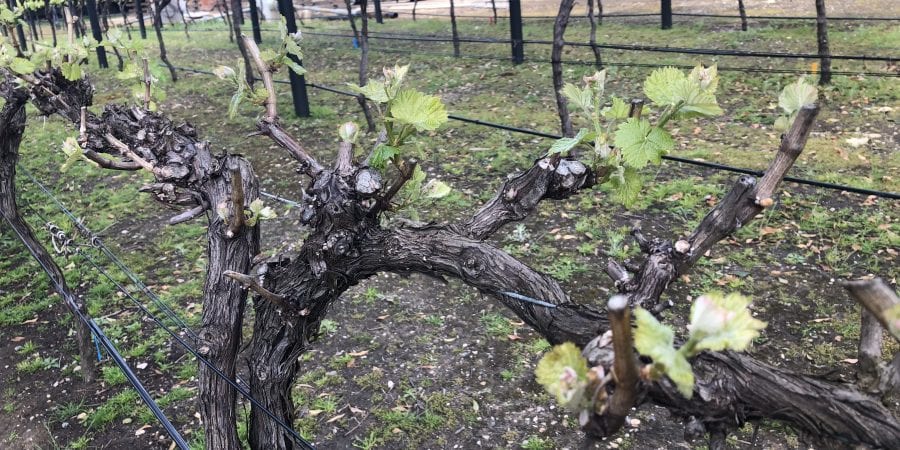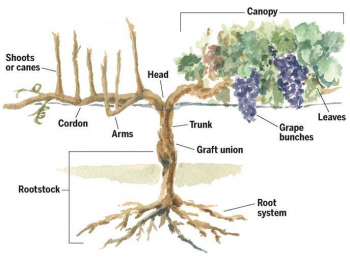Some more wine jargon for you this week.
Although it’s not so much “wine” related as it is “vine” related.
So, perhaps we should call this post… “Vine Jargon Part 1” instead?!
And perhaps I should stop talking about the title and just get on with it?!
Given the warm weather has made a return and we’re well and truly into Spring, you’re going to be hearing a lot of viticulture terminology thrown around in my upcoming posts.
So, as a head start, here is a list of terms you should be familiar (and can impress your friends!) with…
I should probably start with…
What is Viticulture?
Viticulture comes from the Latin word for vine. It is defined as the science, production and study of grapes and is a branch of horticulture. It can be applied to both wine and table grapes (the ones we eat). You might also hear the term viniculture which refers to only wine grapes.
A viticulturist is a horticultural scientist responsible for the growth and production of grapes, typically those used in the making of wine. They are in charge of monitoring and maintaining the vines, manipulating them in order to produce a particular result, as desired by the winemaker.
You may also hear the term vigneron which is a French word sometimes used in place of viticulturist.
And while we’re at it, we may as well add vintner to our list of “V” words. A vintner is a general term used to describe a person who makes wine or sells wines.
Words you’ll hear through the growing season…
Rootstock
Rootstock describes the root system of the vine. The reason we talk about it a lot is that the above-ground parts of some grapevines are grafted onto the rootstock of another type of vine. The rootstock is selected to give the grafted vine more resilience either through root pest resistance, salt tolerance or vigour control.
Canopy
The canopy of a grapevine includes the parts of the vine visible aboveground. That includes the trunk, cordon, stems, leaves, flowers and fruit. Viticulturalists spend a lot of time managing the canopy of their vines (otherwise known as “Canopy management” funnily enough). This usually involves pruning and trimming leaves. They also use trellis systems to train and guide the growth of the canopy. Canopy management is super important because it can affect grape yields, quality, vigour (rate of shoot growth) and can help to prevent grape diseases.
Cordon
The cordon, or “arms”, of the grapevine extend from the trunk and are the part where additional arms and eventually leaves and grape clusters extend. The cordons are usually trained along wires as part of a trellis system. This training usually fixes the cordon into a permanent position, such as horizontal extending from the trunk in opposite directions.
Shoots (or Canes)
The shoot of the vine develops from new buds located on the cordon and grow to include the leaves, tendrils (those curly bits on plants that climb) and eventually grape clusters. Shoots first begin to appear in spring, following budburst, accelerating growth till the flowering stage and usually slowing by the time that the vine begins veraison. During the stage of veraison (typically mid to late summer), the shoot starts to harden and change color from green to brown. At this stage the shoot is ripening and becomes known as a “cane.”
Budburst
We should all be getting pretty familiar with this one by now, but just in case…
Budburst refers to the period in early spring during which grapevines, which have been dormant through the winter, first begin to produce new shoots.
Veraison
Again, something we’ve covered a few times, but worth mentioning again…
Veraison is specifically defined as the stage at which three simultaneous but separate processes begin:
1. Each berry softens as the cells within the grapes begin to produce more juice and the skin becomes thinner.
2. Sugar starts to accumulate and acidity of the grape starts dropping away.
3. Colour starts to change – from green to red in red varieties and from green to translucent in white varieties.
Yield
Yield is commonly referred to as the weight of grapes per area of vineyard and is expressed as tonnes per hectare or tonnes per acre. Yields of Australian vineyards range from about 3 to 40 tonnes per hectare, depending on the variety, site and associated vineyard management practices. There is no magical figure for the optimum yield at any one site. It depends on the style of wine that the winemaker wishes to produce.
When I started this post, I didn’t think I had that many terms to define, but as it turns out, I have too many!. For one post that is. So, let’s come back to this again in a few weeks.
Loving our blog? Sign up for weekly updates straight to your inbox here.
 Cape d’Estaing Zoom!
Cape d’Estaing Zoom!
For all of you who were lucky enough to get your hands on some of Rob’s special release Cape d’Estaing wines… don’t forget our special Zoom chat with Rob scheduled for Sunday. Check your inbox for all the details.
Do you have any questions? Make sure you send them through via email or save them up to ask Rob live during the zoom.
We look forward to seeing you all then!
Vale Taras Ochota
We lost a very important member of our Adelaide Hills winemaking community this week.
I had the pleasure of meeting Taras of Ochota Barrels a handful of times and each time I was struck by how genuinely lovely and friendly he was. He was a talented winemaker, a loving (and massively proud) Dad, husband and Hills icon.
We send our thoughts and sympathy to his family – he will be missed.


